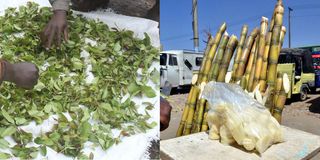Revealed: Muguka, sugarcane sellers among major water polluters

Traders sell the two products -muguka (left) and sugarcane- in banned polythene bags.
Muguka and sugarcane vendors have been identified as major causes of water pollution as Kenya joins nations to commemorate World Wetlands Day on February 2.
This year's World Wetlands Day ceremony will be held at Lake Narasha in Timboroa, Uasin Gishu County.
According to Ecosystems Management Deputy Director Issak Elmi, small-scale muguka and sugarcane vendors have been polluting the water by using polythene paper despite the National Environment Management Authority (NEMA) ban on plastic.
"We have challenges from muguka as well as sugarcane traders who put their products in plastic packaging and sell to people. Please do not buy muguka or sugarcane cut into pieces in polythene paper," he said.
Speaking during the Kenya Vision 2030 Delivery Secretariat Media Sensitisation Forum, Dr Elmi said most of the polythene bags are sourced from Somalia, which is grappling with incessant civil unrest.
"Traders source polythene bags from our neighbour, Somalia. Somalia is a recovering country; the institutional, legal and policy framework is not intact," he said.
To fully implement the plastic ban, the official noted that Somalia, as part of the East African Community, "needs to be brought on board and supported with capacity building so that enforcement on their side is up to standard".
"The border from Lamu to Mandera needs to be secured and that can be done through government-to-government cooperation. That is the biggest threat we have right now."
Elmi, who is also the head of the Marine, Wetlands and Terrestrial Ecosystems Department, has raised the alarm over the escalating pollution of water towers, which has seen available water levels plummet from the recommended 1,000 cubic metres per person per year.
Other factors linked to the plummeting water levels, according to Elmi, include "the effects of climate change, prolonged drought, reckless pollution of the little water that is available, and a growing population that has increased the demand for water".
Under direct attack
"We have to wake up and work around the clock. If we find that even one litre of water is polluted, we should actually mourn because there is not enough water and what little we have is under direct attack from pollution. Nema came up with 'zero tolerance for waste, be it ordinary garbage or plastic plants'."
Water towers are natural water catchments with the capacity to capture rainwater and filter it into underground streams, explains Acting Director for Ecosystem Protection, Rehabilitation and Conservation, Molu Wato.
Kenya has five major water towers, including Mount Kenya, Mount Elgon, Mau Forest Complex, Aberdare Ranges and Cherangany Hills. Fifteen more have recently been gazetted.
To restore watersheds and address the water scarcity dilemma in line with Vision 2030, the government has launched initiatives to rehabilitate barren lands, forests and tree cover.
Zero water source
"In North Horr, we have reclaimed 200 acres from the Chalbi Desert. The water has moved from 14,000 cubes per hour to 784 cubes per hour. The entire town of North Horr now depends on these two springs from zero water source," said Elmi.
Adopt a Wetland is another new model that aims to protect water catchment areas by involving the national and county governments in active environmental conservation.
"We have adopted 10,000 wetlands across the country, complete with GPS. We have come up with this initiative so that our ministries, agencies, departments and county governments take the lead in adopting these wetlands which are in dire need of protection and ensure sustainable water supply without pollution in this country...With the 15 billion target, we can double it."
Wato noted that more than half a million indigenous forests have been rehabilitated to increase tree and forest cover.
"We have rehabilitated 600,000 hectares of natural forests, we have fenced 30 kilometres of Aberdare, part of Mt. Kenya, fencing is ongoing in Kakamega forest, and we have covered 15 kilometres."
Fencing is more effective for natural regeneration because it excludes and reduces anthropogenic activity in natural forests, allowing them to regenerate and regain their water catchment characteristics.
Pure tree canopy
The Food and Agriculture Organization (FAO) of the United Nations defines forest cover as a pure tree canopy of at least 10 per cent cover.
"In our context as a country, we have taken 15 per cent. The canopy has to be at least 0.5 hectares and the trees have to be at least 2 metres high. That is how we can say it is a forest," explains Wato.
"Sparsely populated trees, patches and isolated trees, if we count trees like we do for people, then that's tree cover."
Currently, Kenya has a forest cover of 8.83 per cent and a tree cover of 12 per cent, exceeding the 10 per cent set out in the constitution.
Kenya hopes to plant 15 billion trees by 2032, experts say.




